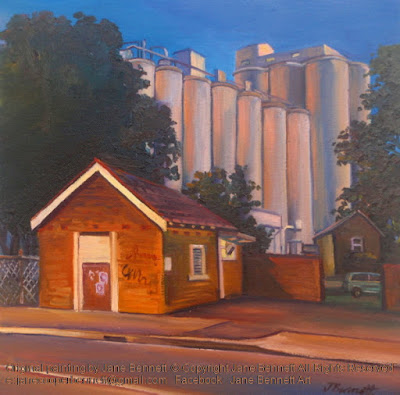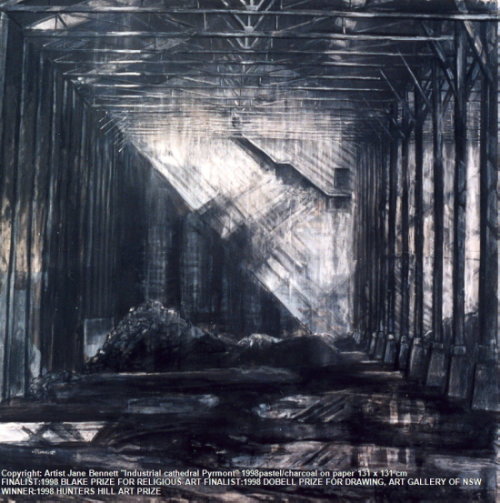
SU9 Summer Hill, Mungo Scott Flour Mills Last Flour truck .
2009 oil on canvas 28 x 36cm
Available for sale
This vast behemoth was the last operational flour mill in Sydney.
Mungo Scott Ltd acquired the land for £3000 in 1916 and built the flour mill with an estimated £10,000 budget in 1921-22.

SU3 Summer Hill Mungo Scott Flour Mills Late Afternoon
2009 oil on canvas 30 x 30cm
Available for sale
It exploited the newly built Metropolitan goods line between Wardell Road and Darling Harbour.
The Summer Hill freight line, alongside Hawthorne Canal, was used twice a week to service the Mills. This branch line was the last operational section of the once mighty Metropolitan goods line before it was redeveloped as light rail/cycling track.
SU2 Summer Hill Mungo Scott Flour Mills Evening
2009 oil on canvas 30 x 30cm
Available for sale
A huge fire in the mill in 1927 was believed to have been caused by sparks caused by passing trains igniting stored flour.
The landmark silos appeared in the early 1950s, as Goodman Fielder grew the Mill’s capacity. Allied Mills took control of the buildings in the 1950s and they were used as a key processing facility for wheat grown in New South Wales until 2009.
The last train ran to the Mungo Scott flour mill on 1 December 2008.

SU1 Summer Hill Mungo Scott Flour Mills by Night
2009 oil on canvas 30 x 30cm
Available for sale
As the Mungo Scott Flour Mills were conveniently close to the Taylor galleries in Smith street where I held regular exhibitions, I was well placed to be able to paint canvases of some of its last operations, including some of the last flour trucks to leave the Mills.
Allied Mills finally vacated the site forever in about 2010 and moved their operations to a huge site in Picton, in Sydney's south-west, which I drive past whenever I exhibit my paintings at the Thirlmere Festival of Steam.
SU6 Summer Hill Mungo Scott Flour Mills Last Flour truck
2009 oil on canvas 41 x 61cm
PRIVATE COLLECTION : SYDNEY
Enquiries about other Summer Hill paintings
The precinct is now redeveloped and is home to offices and more than 400 apartments.
Related Posts
Painting from the silos of the Mungo Scott Flour Mills
The empty mask - Edwin Davey Flour Mills







